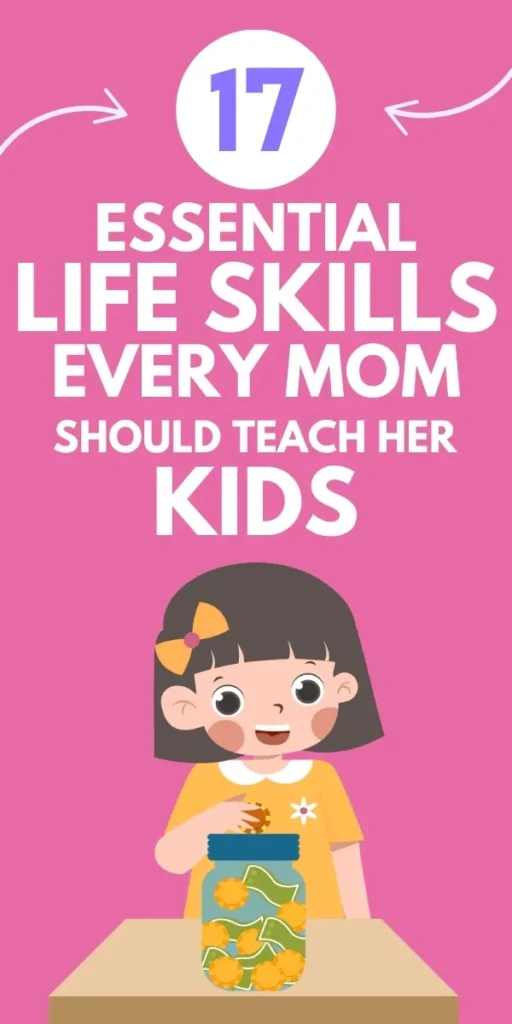Remember that frantic morning when you were running late for work, tripping over toys, and your child couldn’t find a matching sock?
Or the time you spent a frustrating evening battling over who would unload the dishwasher?
These everyday moments highlight the importance of equipping your child with essential life skills.
Think of life skills as the building blocks of independence and resilience.
When you teach your child how to navigate basic tasks and handle situations, you’re setting them up for success not just at home, but throughout their lives.
And this is the Only guide you’ll need to find which life skills to teach your child and more importantly How to go about teaching it in simple words.
So let’s get into it!
Table of Contents
Why Should We Teach Life Skills to Children?
Life skills go beyond academics.
They empower your child to take charge, solve problems, and build confidence.
Imagine your teenager confidently cooking a healthy meal, managing their allowance wisely, or asking for help with a challenging homework assignment.
These skills not only make your life easier, but also foster a sense of responsibility and self-reliance in your child.
Basic Life Skills to Teach Your Child
Here are the 17 basic life skills that you can teach your child and how to go about teaching them:
1. Home Management

Turn chores into a family effort! Assign age-appropriate tasks like setting the table, sorting laundry, or dusting shelves.
Create a chore chart with visuals for younger children.
Let your child take ownership of their space by encouraging them to make their bed or tidy their room. This fosters responsibility and teaches them the value of teamwork.
2. Preparing Basic Meals

Forget takeout every night! Equipping your child with basic cooking skills fosters healthy habits, independence, and a sense of accomplishment.
Start small! Involve your child in age-appropriate tasks like washing vegetables, stirring ingredients, or setting the table.
Here are some tips to get you started:
- Keep it Simple: Focus on easy recipes like quesadillas, pasta with pesto, or fruit smoothies.
- Safety First: Teach your child about kitchen safety – hot stovetops, sharp knives, and the importance of washing hands.
- Make it Fun: Play upbeat music, create a themed meal night, or let your child choose a recipe from a kid-friendly cookbook.
Remember, the goal is to create a positive experience, not Michelin-star cuisine. As your child’s confidence grows, gradually introduce more complex tasks like chopping vegetables or using the oven.
3. Time Management Skills
Juggling school, activities, and homework can feel overwhelming for kids.
Teaching them time management skills equips them to take control of their schedules and reduces stress.
Here’s how:
- Create a Routine: Establish a consistent bedtime, wake-up time, and designated times for homework and chores. Visual schedules with pictures or stickers work well for younger children.
- Break it Down: Help your child break down larger tasks into smaller, manageable steps. For example, a history project could involve researching on Monday, outlining on Tuesday, and writing on Wednesday.
- Embrace Calendars and Timers: Use a colorful calendar to track deadlines and set timers to stay focused during homework sessions.
4. Doing Laundry

The mystery of the missing sock may never be solved, but your child can definitely learn to conquer laundry!
Here’s how to turn this chore into a learning experience:
- Sorting 101: Start by teaching your child to sort clothes by color (darks, lights, delicates) and temperature (hot, cold). Explain why separating laundry protects garments from shrinking or fading.
- Machine Magic: Demystify the washing machine together. Show your child how to load clothes, add detergent, and choose the appropriate cycle. Let them press the buttons (with supervision!) and feel a sense of accomplishment.
- Folding Fundamentals: Folding clothes might seem simple, but it’s a valuable skill. Teach your child basic folding techniques for shirts, pants, and pyjamas. This not only helps with organization but also saves precious drawer space.
Remember, patience is key. Laundry mishaps might happen – a pink sock turning red, for example. Use these moments as teaching opportunities about stain removal or reading care labels.
5. Self-Care
From personal hygiene to healthy eating, self-care skills are essential for a child’s well-being.
Here are some ways to empower your child:
- Hygiene: Establish a consistent routine for brushing teeth, washing hands, and taking baths or showers. Use fun songs or games to make it engaging.
- Fueling for Fun: Involve your child in planning healthy meals and snacks. Let them choose fruits and vegetables at the grocery store or help prepare simple dishes like yogurt parfaits or whole-wheat sandwiches.
- Sweet Dreams: Develop a relaxing bedtime routine that includes taking a warm bath, reading a book, or listening to calming music. This promotes good sleep habits, crucial for a child’s overall health and development.
6. Asking for Help

Knowing when and how to ask for help is a powerful life skill. It fosters independence, builds confidence, and strengthens relationships.
Here’s how to encourage your child to seek help:
- Normalize It: Make asking for help a positive experience. When your child struggles with a task, say things like, “Let’s figure this out together,” or “Is there anything I can do to help?”
- Open Communication: Create a safe space for your child to express their needs and frustrations. Listen actively and avoid getting frustrated if they ask for help with something you think they should already know.
- Role-Playing: Practice asking for help in different scenarios. Help your child brainstorm ways to phrase their request politely and respectfully.
7. How to Say “No”
Saying “no” is an important life skill that allows your child to set boundaries and express their needs.
Here are some tips:
- Start Early: Teach your child basic refusal skills with simple phrases like “No, thank you” or “I don’t want to.”
- Respectful Communication: Encourage your child to explain their reasons for saying no in a polite way. For example, “No, thank you, I’m full,” or “No, I’d rather play outside now.”
- Natural Consequences: Sometimes, the best lesson is a natural consequence. If your child refuses to wear a jacket on a cold day, let them experience the discomfort briefly before offering a solution.
8. Coping with Failure
Failure is an inevitable part of life, but it doesn’t have to be a defining moment.
Equipping your child with skills to cope with setbacks builds resilience and fosters a growth mindset.
Here’s how to help them navigate disappointment:
- Validate Their Feelings: Acknowledge your child’s emotions – frustration, sadness, or anger are all normal reactions to failure. Let them know it’s okay to feel disappointed.
- Focus on the Effort: Shift the focus from the outcome to the effort they put in. Say things like, “I saw how hard you studied for that test,” or “You practiced your soccer skills a lot this week!”
- Turn Setbacks into Learning Opportunities: Help your child analyze what went wrong. Ask questions like, “What can we learn from this experience?” or “How can we approach this differently next time?”
- Celebrate Small Wins: Encourage your child to celebrate small victories along the way. This reinforces a positive attitude and keeps them motivated.
9. Money Management

Financial literacy empowers your child to make informed decisions about money.
Here’s how to nurture this crucial skill:
- Start Early: Introduce basic money concepts like saving, spending, and earning. Use piggy banks for saving and involve them in age-appropriate shopping trips to discuss budgeting.
- Allowance with a Purpose: Consider a regular allowance tied to chores or responsibilities. This teaches the value of work and helps them manage their money. Encourage them to set saving goals, like a new toy or book.
- Open a Savings Account: Open a kid-friendly savings account with your child and explain the concept of interest. Celebrate milestones like reaching a savings goal!
10. Organizational Skills
Organization is key to managing time effectively and reducing stress.
Here are some tips to help your child become an organizational whiz:
- Designated Spaces: Create designated storage areas for toys, books, and school supplies. Label shelves and drawers with pictures or words for younger children.
- Planning and Prioritization: Teach your child to create daily to-do lists or use a planner to prioritize tasks. Help them break down large projects into smaller, more manageable steps.
- Cleaning Routines: Establish a regular cleaning routine together. Assign age-appropriate tasks like putting away toys or picking up their clothes.
11. Goal Setting
Goal setting empowers your child to dream big, break down challenges, and celebrate achievements.
Here’s how to guide them:
- Dream It Up: Encourage your child to brainstorm their goals, big or small. It could be anything from learning a new skill to mastering a sport.
- SMART Goals: Introduce the concept of SMART goals – Specific, Measurable, Achievable, Relevant, and Time-bound. Help them create achievable goals with clear deadlines.
- Action Plan & Support: Work with your child to develop an action plan to reach their goals. Break down larger goals into smaller steps and celebrate milestones along the way. Offer support and encouragement throughout the process.
12. Self-Discipline
Self-discipline allows your child to control their impulses, manage distractions, and stay focused on tasks.
Here are some ways to nurture it:
- Daily Routines: Establish consistent routines for waking up, bedtime, meals, and homework. This provides a sense of structure and predictability.
- Limited Choices: Reduce decision fatigue by offering limited choices for certain activities. For example, instead of asking “What do you want for breakfast?” present two healthy options.
- Positive Reinforcement: Focus on praising your child’s effort and self-control. Phrases like “I see you focused hard on your homework” or “You resisted the candy at the store, great job!” reinforce positive behavior.
Remember, self-discipline is a muscle that needs to be exercised.
13. Safety Skills
Equipping your child with safety skills empowers them to navigate the world with confidence and avoid potential dangers.
Here are some key areas to focus on:
- Stranger Danger: Teach your child the concept of stranger danger. Explain that not everyone with them wants to help, and it’s okay to say “no” and walk away from someone they don’t know. Practice saying “No, thank you, I need to find my mom/dad” together.
- Personal Safety Rules: Establish clear personal safety rules. This could include not leaving playgrounds alone, asking permission before going anywhere, and knowing their home address and phone number (or how to reach you) in case of emergencies.
- Body Safety: Teach your child about body safety and appropriate touch. Explain that certain parts of their body are private and no one should touch them without permission. Encourage them to tell you if anyone makes them feel uncomfortable.
- Home Safety: Walk through basic home safety rules together. Teach them about fire safety, like recognizing smoke alarms and practicing fire drills. Discuss how to handle electrical hazards and what substances in the house are off-limits.
- Traffic Safety: Teach your child pedestrian safety. Explain the importance of looking both ways before crossing the street, using crosswalks, and never running into traffic.
Remember, safety education is an ongoing process. Tailor your approach to your child’s age and understanding. Role-playing different scenarios can be a helpful way to reinforce these important lessons.
14. Navigational Skills
Equipping your child with basic navigational skills fosters independence and a sense of direction. Here’s how to get them started:
- Maps and Landmarks: Introduce your child to maps and globes. Point out familiar landmarks in your neighborhood and teach them basic directional terms like north, south, east, and west.
- Treasure Hunts: Turn everyday outings into learning experiences. Organize neighborhood treasure hunts with simple clues that involve navigating streets and landmarks.
- Compass Games: For older children, introduce a compass and practice basic orienteering skills. Play games in parks or backyards where they need to use the compass to find hidden objects.
15. Basic Sewing

Learning to sew a button back on or mend a small tear empowers your child with a sense of accomplishment and practical skills.
Here’s how to introduce them to the wonderful world of sewing:
- Start Simple: Begin with blunt needles and yarn on felt fabric. Teach them basic stitching techniques like a straight stitch or a whip stitch.
- DIY Projects: Find age-appropriate sewing projects like decorating pillowcases, creating no-sew fleece blankets, or hand-stitching simple felt toys.
- Safety First: Always supervise your child when using needles and scissors. Teach them proper handling techniques and safe storage practices.
Basic sewing skills not only promote resourcefulness but also spark creativity and a sense of accomplishment in your child.
16. Social Etiquette
Social etiquette equips your child to interact with others respectfully and build positive relationships.
Here are some key areas to focus on:
- Greetings and Introductions: Teach your child basic greetings like “hello,” “goodbye,” and “please” and “thank you.” Practice introducing themselves to others and using appropriate titles like Mr., Ms., or Dr.
- Table Manners: Establish basic table manners like using utensils properly, sitting up straight, and avoiding talking with their mouth full.
- Respectful Communication: Encourage your child to listen attentively when others speak, avoid interrupting, and use kind words.
17. Responsible Internet Use

The internet is a vast and valuable resource, but it also comes with potential risks.
Here’s how to equip your child to use the internet safely and responsibly:
- Open Communication: Maintain open communication about your child’s online activities. Encourage them to come to you with any questions or concerns they encounter.
- Digital Citizenship: Teach your child about digital citizenship. Discuss topics like cyberbullying, online privacy, and responsible online behavior.
- Setting Boundaries: Establish clear boundaries around internet usage. This includes setting time limits, designated screen-free zones (bedrooms, mealtimes), and age-appropriate websites and apps.
- Parental Controls: Utilize parental controls on devices and browsers to filter inappropriate content and limit screen time.
- Privacy and Security: Teach your child about online privacy. Explain the importance of not sharing personal information or passwords with strangers online. Encourage them to be cautious about clicking on unknown links or downloading attachments.
Conclusion
So there you have it!
Equipping your child with these essential life skills empowers them to sail through the world with confidence, independence, and resilience.

